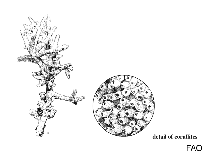Astreopora myriophthalma (Lamarck, 1816)
Porous star coralWarning: DOMDocument::load(): SSL operation failed with code 1. OpenSSL Error messages: error:140770FC:SSL routines:SSL23_GET_SERVER_HELLO:unknown protocol in C:\Apache24\htdocs\includes\SpeciesSummary.lib.php on line 1236
Warning: DOMDocument::load(): Failed to enable crypto in C:\Apache24\htdocs\includes\SpeciesSummary.lib.php on line 1236
Warning: DOMDocument::load(https://sealifebase.nrm.se/webservice/AquaMaps/getAMap.php?genus=Astreopora&species=myriophthalma): failed to open stream: operation failed in C:\Apache24\htdocs\includes\SpeciesSummary.lib.php on line 1236
Warning: DOMDocument::load(): I/O warning : failed to load external entity "https://sealifebase.nrm.se/webservice/AquaMaps/getAMap.php?genus=Astreopora&species=myriophthalma" in C:\Apache24\htdocs\includes\SpeciesSummary.lib.php on line 1236
Envoyez vos Photos
Images Google | No image available for this species;
drawing shows typical species in Acroporidae.
Images Google | No image available for this species;
drawing shows typical species in Acroporidae.
Classification / Names Common names | Synonyms | CoL | ITIS | WoRMS
| Scleractinia | Acroporidae
Environment: milieu / climate zone / depth range / distribution range Écologie
Récifal; profondeur 3 - 20 m (Ref. 98471). Tropical; 35°N - 30°S, 32°E - 108°W (Ref. 846)
Distribution Pays | Zones FAO | Écosystèmes | Occurrences | Introductions
Indo-Pacific. Tropical to subtropical.
Length at first maturity / Taille / Poids / Âge
Maturity: Lm ? range ? - ? cm
Most reef habitats except turbid water (Ref. 846). Carries dense populations of the bivalve L. simplex. Bivalves are completely enclosed by the skeleton. They benefit from the coral through nutrition and protection against predators. The coral's gain, however, is unclear (Ref. 115168).
Life cycle and mating behavior Maturité | Reproduction | Frai | Œufs | Fécondité | Larves
Hermaphroditic (Refs. 113708, 113712). Mature gametes are shed into the coelenteron and spawned through the mouth. Life cycle: The zygote develops into a planktonic planula larva. Metamorphosis begins with early morphogenesis of tentacles, septa and pharynx before larval settlement on the aboral end (Ref. 833).
Référence principale
Références | Coordinateur | Collaborateurs
Veron, J.E.N. 2000. (Ref. 846)
Statut dans la liste rouge de l'IUCN (Ref. 130435)
Least Concern (LC) ; Date assessed: 03 January 2008
statut CITES (Ref. 108899)
Appendix II: International trade monitored
CMS (Ref. 116361)
Not Evaluated
Menace pour l'homme
Utilisations par l'homme
| FishSource |
Outils
Plus d'informations
Pays
Zones FAO
Écosystèmes
Occurrences
Introductions
Stocks
Écologie
Régime alimentaire
Éléments du régime alimentaire
Zones FAO
Écosystèmes
Occurrences
Introductions
Stocks
Écologie
Régime alimentaire
Éléments du régime alimentaire
Sources Internet
BHL | BOLD Systems | CISTI | DiscoverLife | FAO(Publication : search) | Fishipedia | GenBank (genome, nucleotide) | GloBI | Gomexsi | Google Books | Google Scholar | Google | PubMed | Hexacorallians of the World | Arbre de Vie | Wikipedia (Go, chercher) | Zoological Record
Estimates based on models
Preferred temperature
(Ref. 115969): 25 - 29.3, mean 28.4 (based on 3492 cells).
Catégorie de prix
(Ref. 80766):
Unknown.



